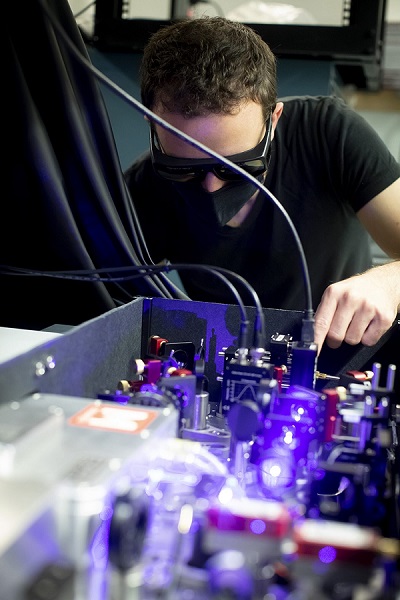A team of physicists from the Harvard-MIT Center for Ultracold Atoms and other universities has developed a special type of quantum computer known as a programmable quantum simulator capable of operating with 256 quantum bits, or “qubits.” According to lead author Sepehr Ebadi, a graduate student at Harvard University, it is the combination of the system’s unprecedented size and programmability that puts it at the cutting edge of the race for a quantum computer.
The project uses a significantly upgraded version of a platform developed in 2017, which was capable of reaching a size of 51 qubits. That older system allowed the researchers to capture ultracold rubidium atoms and arrange them in a specific order using a one-dimensional array of optical tweezers.

Dolev Bluvstein looks at a 420-mm laser that allows researchers to control and entangle Rydberg atoms. Courtesy of Harvard University.
The team’s new system enables the atoms to be assembled in two-dimensional arrays of optical tweezers. This increases the achievable system size from 51 to 256 qubits. Using the tweezers, researchers can arrange the atoms in defect-free patterns and create programmable shapes to engineer different interactions between the qubits.
“The number of quantum states that are possible with only 256 qubits exceeds the number of atoms in the solar system,” Ebadi said.
The workhorse of the new platform, Ebadi said, is the spatial light modular. The device is similar in some ways to the core technology of a computer projector to display images on a screen. In the platform, the spatial light modulator is used to shape an optical wavefront to produce hundreds of individually focused optical tweezer beams.
The initial loading of the atoms into the optical tweezers is random, and the researchers must move the atoms around to arrange them into their target geometries. The researchers use a second set of moving optical tweezers to drag the atoms to their desired location, eliminating the initial randomness. Lasers give the researchers complete control over the positioning of the atomic qubits and their coherent quantum manipulation.
“This moves the field into a new domain where no one has ever been to thus far,” said Mikhail Lukin, the George Vasmer Leverett Professor of Physics, the co-director of the Harvard Quantum Initiative in Science and Engineering, and one of the senior authors of the research paper. “We are entering a completely new part of the quantum world.”
The researchers are working to improve the system by improving laser control over qubits and making the system more programmable. They are also exploring how the system can be used for new applications, ranging from probing exotic forms of quantum matter to solving challenging real-world problems that can be naturally encoded on the qubits.
The work was supported by the Center for Ultracold Atoms, the NFS, the Vannevar Bush Faculty Fellowship, the U.S. Department of Energy, the Office of Naval Research, the Army Research Office, MURI (Multidisciplinary University Research Initiative), and the DARPA ONISQ (Optimization with Noisy Intermediate-Scale Quantum Devices Program).
The research was published in Nature (www.doi.org/10.1038/s41586-021-03582-4).